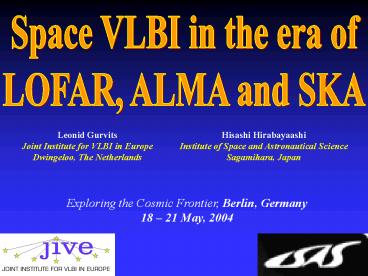Leonid Gurvits - PowerPoint PPT Presentation
1 / 21
Title: Leonid Gurvits
1
Space VLBI in the era of LOFAR, ALMA and SKA
Leonid Gurvits Joint Institute for VLBI in
Europe Dwingeloo, The Netherlands
Hisashi Hirabayaashi Institute of Space and
Astronautical Science Sagamihara, Japan
Exploring the Cosmic Frontier, Berlin, Germany 18
21 May, 2004
2
Why VLBI in Space?
Lobanov 2002 poster 52
3
The question whats going on at 1012 lt TB lt 1016
K?
- What are the most compact radio structures in
AGN? - What is the highest brightness temperature in
AGN? - Note the highest LOWER LIMIT of TB measured
directly to date - 5.8 x 1013 K (AO0235164, VSOP, Frey et al.
2000)
4
Space VLBI at ? versus ground-based Global VLBI
at ? /3
Simulated images with similar angular resolution
and comparable sensitivity
Longer baselines at lower frequencies are
COMPLEMENTARY to shorter baselines at higher
frequencies
See also posters 39 by Agudo et al and 43 by
Krichbaum et al.
5
Three generations of VLBI in Space
2000s
1990s
1986-88
VSOP-2, Ø 12m
RadioAstron, Ø 10m
ARISE, Ø 25m
TDRSS-OVLBI, Ø 5m
Plus KRT-30 (1978-82) QUASAT (1980s) IVS
(1987-91) ALFA (1990s)
VSOP, Ø 8m
ISS-SVLBI, Ø 30m
6
VLBI Space Obsrvatory Programme (VSOP) ISAS,
Japan world-wide collaboration (in orbit since
1997)
HALCA
7
VSOP AGN Survey at 5 GHz (1997-2004)
- 402 extragalactic radio sources (mostly AGN)
- Selection criteria
-
- Plus all sources in the
visible part of the sky
More info on VSOP Survey http//www.vsop.isas.ac
.jp Hirabayashi et al. 2000, PASJ 52,
997 Lovell et al, 2004, ApJ Suppl, in
press Scott et al. 2004, ApJ Suppl, in
press Horiuchi et al. 2004, ApJ, submitted
8
VSOP AGN Survey imaging results (Scott et al.
2004)
9
AGN cores in VSOP AGN Survey (Scott et al. 2004)
Open area resolved cores Shaded area
unresolved cores (upper limits)
Random sub-set of 101 AGN from the VSOP Survey
list
10
VSOP AGN Survey non-imaging analysis (Horiuchi
et al. 2004)
11
VSOP AGN Survey non-imaging analysis (Horiuchi
et al. 2004)
NB1 .but beware of IDV sources (i.e.J18193845,
core 0.01 mas)
NB2 The highest directly measured value of
TB 5.8 x 1013 K (VSOP data on AO
0235164, Frey et al. 2000)
Averaged normalised visibility
12
Toward 10,000 sources
Data points 300 AGN Imaged _at_ 5 GHz (ad-hoc)
with mas angular resolution (Gurvits et al. 1999)
De-facto flux density selection!
New territory for new radio telescopes,
especially Global SKA!
Need to observe mJy-level sources with 1023
1025 W/Hz objects at zgt0.5
13
The sky area of DEVOS NGP (North Galactic Pole)
DEVOS Deep Extragalactic VLBI-Optical Survey
14
F-ref calibrator
The deepest2 VLBI image to date SDSS 08360054 _at_
z5.82 EVN, ?18 cm, 1.1 mJy/beam
10 mas
10
background NVSS
15
VSOP Survey conclusions compactness of the cores
- Strange coincidences cosmic conspiracy?
- 1012 K is about the maximum measurable brightness
temperature with the baseline 10,000 km. - We happen to live on the interferometrically
correct planet! - The most compact structures in AGN begin to
appear at baselines 200 M? - (1 mas), just a bit longer than available on the
Earth at 5 GHz, the most popular VLBI frequency
of the recent past. - Again, we live on a very special planet!
- Both the items above have become known to us
essentially owing to baselines longer than the
Earth diameter (VSOP). Baselines 10,000 100,000
km (Space VLBI) and sub-mJy sensitivity are
crucial! - Radio structures lt 1 mas are likely to be the
last bastion on the way to complete resolution of
the cores definitive diagnostics of the SMBH
accretion disc jet system.
16
What is next?
- Sensitivity!
- microjansky per mas-scale beam
- Angular resolution at VARIOUS frequencies
(matched with sensitivity) - 10 microarcseconds at mm and cm wavelengths
- Full sky coverage
- In-beam phase-referencing phase calibrators
- ANYWHERE on the sky
17
VSOP-2, proposal by ISAS/JAXA(Japan)
- VSOP-2 is a mission for the highest resolution
imaging of AGN and young stellar objects. - Improvements over VSOP by factors of 10
- Higher frequency
- Highest observing frequency 43GHz
- Higher resolution
- 38 micro arcsecond _at_43GHz
- Higher sensitivity
- The angular resolution is approaching the
dimensions of - accretion disk and black hole in nearby AGN
- jet launching site
- Structure of magnetospheres of protostar
See also poster 4 by Hirabayashi et al.
18
Summary of VSOP-2 Science Goals
- Key science
- Jet structure, collimation and acceleration
regions - Structure of accretion disks around AGN
- Structure of magnetic fields in protostars
- Other targets
- Galactic masers in star-forming region
- Extragalactic Megamasers
- Radio quiet quasars
- X-ray binaries, SNR, gravitational lenses etc.
19
Direct view at a super-massive black hole
- With an angular resolution for M87 of 10 Rg
(Schwarzschild radius) , detection of the black
hole shadow may be possible
20
VSOP-2
- Observing Freq. 8, 22, 43 GHz
- Cooled receivers (22 and 43 GHz)
- Wide band data downlink (1 Gbps)
- Apogee height 25000 km
- 75 µasec _at_ 22 GHz
- 38 µasec _at_ 43 GHz
- Dual polarization
- LCP/RCP
- Phase-referencing capability
- Switching the main reflector
21
VSOP-2 satellite
- 9-m offset cassegrain antenna with module
structures - Light weight
- Easy adjustment
- Mass (wet) 910Kg
- Power 1800W
22
Forward look
Space Sub-mm Array (ALMA in space)
VSOP-2
BH imager
VSOP-4
VSOP-3
Sub-mm Telescope
VSOP































